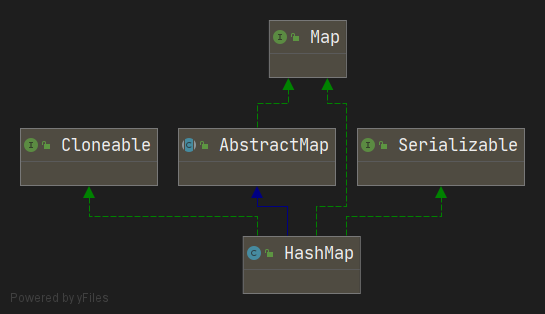常见相关实现类总结 1)HashMap:
遍历顺序不确定;
最多只允许一条记录的键为null,允许多条记录的值为null;
非线程安全,若需保证线程安全,可以用Collections的synchronizedMap(),或者ConcurrentHashMap;
2)Hashtable:
线程安全,因为方法都用synchronized修饰,并发性不如ConcurrentHashMap;
3)LinkedHashMap
是HashMap的一个子类,保存了记录的插入顺序;
4)TreeMap
实现SortedMap接口,默认是按照键值的升序排序,也可以指定排序的比较器;
在使用TreeMap时,key必须实现Comparable接口或者在构造TreeMap传入自定义的Comparator,否则会在运行时抛出异常java.lang.ClassCastException;
源码分析 基本属性 static final int DEFAULT_INITIAL_CAPACITY = 1 << 4 ; static final int MAXIMUM_CAPACITY = 1 << 30 ; static final float DEFAULT_LOAD_FACTOR = 0.75f ; static final int TREEIFY_THRESHOLD = 8 ; static final int UNTREEIFY_THRESHOLD = 6 ; static final int MIN_TREEIFY_CAPACITY = 64 ;
定位哈希桶数组索引位置 static final int hash (Object key) int h; return (key == null ) ? 0 : (h = key.hashCode()) ^ (h >>> 16 ); } int n = tab.length;int index = (n - 1 ) & hash;
步骤:
拿到 key 的 hashCode 值;
将 hashCode 的高位参与运算,重新计算 hash 值;
将计算出来的 hash 值与 (table.length - 1) 进行&运算;
总结:当 table.length = 16 时,table.length - 1 = 15,此时低 4 位全为 1,高 28 位全为 0,与 0 进行 & 运算必然为 0,因此此时(n - 1) & hash 的运算结果只取决于hash的低四位,此时hash冲突概率增加。因此,在 JDK 1.8 中,将高位也参与计算 (h = key.hashCode()) ^ (h >>> 16),目的是降低 hash 冲突的概率。
put() public V put (K key, V value) return putVal(hash(key), key, value, false , true ); } final V putVal (int hash, K key, V value, boolean onlyIfAbsent, boolean evict) Node<K,V>[] tab; Node<K,V> p; int n, i; if ((tab = table) == null || (n = tab.length) == 0 ) n = (tab = resize()).length; if ((p = tab[i = (n - 1 ) & hash]) == null ) tab[i] = newNode(hash, key, value, null ); else { Node<K,V> e; K k; if (p.hash == hash && ((k = p.key) == key || (key != null && key.equals(k)))) e = p; else if (p instanceof TreeNode) e = ((TreeNode<K,V>)p).putTreeVal(this , tab, hash, key, value); else { for (int binCount = 0 ; ; ++binCount) { if ((e = p.next) == null ) { p.next = newNode(hash, key, value, null ); if (binCount >= TREEIFY_THRESHOLD - 1 ) treeifyBin(tab, hash); break ; } if (e.hash == hash && ((k = e.key) == key || (key != null && key.equals(k)))) break ; p = e; } } if (e != null ) { V oldValue = e.value; if (!onlyIfAbsent || oldValue == null ) e.value = value; afterNodeAccess(e); return oldValue; } } ++modCount; if (++size > threshold) resize(); afterNodeInsertion(evict); return null ; }
总结:
插入操作的入口方法是 put(K,V),但核心逻辑在V putVal(int, K, V, boolean, boolean) 方法中。putVal()主要流程如下:
①.判断键值对数组table[i]是否为空或为null,否则执行resize()进行扩容;
②.根据键值key计算hash值得到插入的数组索引i,如果table[i]==null,直接新建节点添加,转向⑥,如果table[i]不为空,转向③;
③.判断table[i]的首个元素是否和key一样,如果相同直接覆盖value,否则转向④,这里的相同指的是hashCode以及equals;
④.判断table[i] 是否为treeNode,即table[i] 是否是红黑树,如果是红黑树,则直接在树中插入键值对,否则转向⑤;
⑤.遍历table[i],判断链表长度是否大于8,大于8的话把链表转换为红黑树,在红黑树中执行插入操作,否则进行链表的插入操作;遍历过程中若发现key已经存在直接覆盖value即可;
⑥.插入成功后,判断实际存在的键值对数量size是否超多了最大容量threshold,如果超过,进行扩容。
resize() final Node<K,V>[] resize() { Node<K,V>[] oldTab = table; int oldCap = (oldTab == null ) ? 0 : oldTab.length; int oldThr = threshold; int newCap, newThr = 0 ; if (oldCap > 0 ) { if (oldCap >= MAXIMUM_CAPACITY) { threshold = Integer.MAX_VALUE; return oldTab; } else if ((newCap = oldCap << 1 ) < MAXIMUM_CAPACITY && oldCap >= DEFAULT_INITIAL_CAPACITY) newThr = oldThr << 1 ; } else if (oldThr > 0 ) newCap = oldThr; else { newCap = DEFAULT_INITIAL_CAPACITY; newThr = (int )(DEFAULT_LOAD_FACTOR * DEFAULT_INITIAL_CAPACITY); } if (newThr == 0 ) { float ft = (float )newCap * loadFactor; newThr = (newCap < MAXIMUM_CAPACITY && ft < (float )MAXIMUM_CAPACITY ? (int )ft : Integer.MAX_VALUE); } threshold = newThr; @SuppressWarnings({"rawtypes","unchecked"}) Node<K,V>[] newTab = (Node<K,V>[])new Node[newCap]; table = newTab; if (oldTab != null ) { for (int j = 0 ; j < oldCap; ++j) { Node<K,V> e; if ((e = oldTab[j]) != null ) { oldTab[j] = null ; if (e.next == null ) newTab[e.hash & (newCap - 1 )] = e; else if (e instanceof TreeNode) ((TreeNode<K,V>)e).split(this , newTab, j, oldCap); else { Node<K,V> loHead = null , loTail = null ; Node<K,V> hiHead = null , hiTail = null ; Node<K,V> next; do { next = e.next; if ((e.hash & oldCap) == 0 ) { if (loTail == null ) loHead = e; else loTail.next = e; loTail = e; } else { if (hiTail == null ) hiHead = e; else hiTail.next = e; hiTail = e; } } while ((e = next) != null ); if (loTail != null ) { loTail.next = null ; newTab[j] = loHead; } if (hiTail != null ) { hiTail.next = null ; newTab[j + oldCap] = hiHead; } } } } } return newTab; }
分为两步:
扩容:创建一个新的空数组,长度是原数组的两倍;
rehash:遍历原数组,将所有Node重新Hash到新数组;
因为扩容的代码比较长, 我用文字来叙述下HashMap扩容的过程:
treeifyBin() final void treeifyBin (Node<K,V>[] tab, int hash) int n, index; Node<K,V> e; if (tab == null || (n = tab.length) < MIN_TREEIFY_CAPACITY) resize(); else if ((e = tab[index = (n - 1 ) & hash]) != null ) { TreeNode<K,V> hd = null , tl = null ; do { TreeNode<K,V> p = replacementTreeNode(e, null ); if (tl == null ) hd = p; else { p.prev = tl; tl.next = p; } tl = p; } while ((e = e.next) != null ); if ((tab[index] = hd) != null ) hd.treeify(tab); } }
tableSizeFor(int cap) static final int tableSizeFor (int cap) int n = cap - 1 ; n |= n >>> 1 ; n |= n >>> 2 ; n |= n >>> 4 ; n |= n >>> 8 ; n |= n >>> 16 ; return (n < 0 ) ? 1 : (n >= MAXIMUM_CAPACITY) ? MAXIMUM_CAPACITY : n + 1 ; }
Node static class Node <K ,V > implements Map .Entry <K ,V > final int hash; final K key; V value; Node<K,V> next; Node(int hash, K key, V value, Node<K,V> next) { ... } public final K getKey () public final V getValue () public final String toString () public final int hashCode () public final V setValue (V newValue) public final boolean equals (Object o) }
思考
为什么哈希桶数组table的长度length大小必须为2的n次方?
相对来说素数导致冲突的概率要小于合数,例如,Hashtable初始化桶大小为11(Hashtable扩容后不能保证还是素数)
HashMap采用这种非常规设计,主要是为了在取模和扩容时做优化,同时为了减少冲突,HashMap定位哈希桶索引位置时,也加入了高位参与运算的过程。
resize() 1.8相对于1.7做了什么优化?
在jdk1.8中不需要像jdk1.7的实现那样重新计算hash,只需要看看原来的hash值新增的那个bit是1还是0就好了,是0的话索引没变,是1的话索引变成“原索引+oldCap”。
为什么jdk8开始使用尾插法?
jdk7使用头插法会颠倒原来一个桶里面链表的顺序,在并发时原来的顺序被另一个线程a颠倒了,而被挂起线程b恢复后拿到扩容前的节点和顺序继续完成第一次循环后,又遵循a线程扩容后的链表顺序重新排列链表中的顺序,最终形成了环。
总结:当两个线程分别对hashmap进行插入操作,并且都发生了扩容,并且重新扩容后的定位又在同一个桶,使用头插法时就会导致成环。
使用尾插法在扩容时会保持链表元素原本的顺序,就不会出现链表成环的问题了。但依然无法保证线程安全。例如,线程A和B同时进行put操作,刚好这两条不同的数据hash值一样,并且该位置数据为null,假设线程A进入判断后还未进行数据插入时挂起,而线程B正常执行,正常插入数据,然后线程A获取CPU时间片,此时线程A不用再进行hash判断了,问题出现:线程A会把线程B插入的数据给覆盖 ,发生线程不安全。
为什么hashmap的默认初始化大小是16?
static final int DEFAULT_INITIAL_CAPACITY = 1 << 4 ;
为了服务将key映射到index的算法 index = HashCode(Key) & (Length - 1),Length - 1的值是所有二进制位全为1,这种情况下,index的结果等同于HashCode后几位的值,只要hashcode分布均匀,hash算法的结果就是分布均匀的,所以默认长度为16,是为了降低hash碰撞的几率。
为什么hashmap线程不安全?
线程A和B同时进行put操作,刚好这两条不同的数据hash值一样,并且该位置数据为null,假设线程A进入判断后还未进行数据插入时挂起,而线程B正常执行,正常插入数据,然后线程A获取CPU时间片,此时线程A不用再进行hash判断了,问题出现:线程A会把线程B插入的数据给覆盖 ,发生线程不安全。
当同一个索引位置的节点在增加后达到 9 个,并且此时数组的长度大于等于 64,则会触发链表节点(Node)转红黑树节点(TreeNode),转成红黑树节点后,其实链表的结构还存在,通过 next 属性维持。而如果数组长度小于64,则不会触发链表转红黑树,而是会进行扩容。
当同一个索引位置的节点在移除后达到 6 个时,并且该索引位置的节点为红黑树节点,会触发红黑树节点转链表节点。


